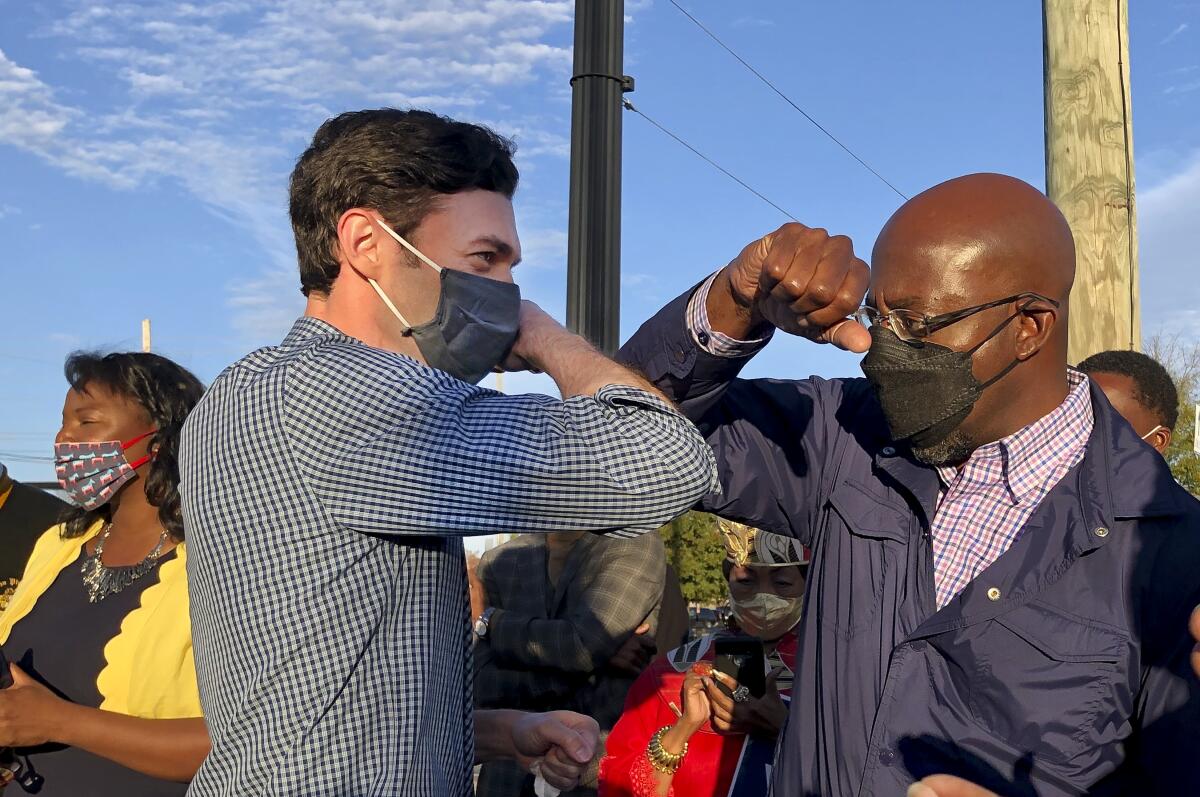A historic alliance rekindled by Raphael Warnock and Jon Ossoff

- Share via
Every year on Martin Luther King Jr. Day, countless Jewish synagogues and community centers hold commemorative events. These ceremonies pay homage not only to King but also to the alliance of Black Americans and Jews that was integral to the civil rights movement.
All too often, though, these services have engaged in mere nostalgia, pining for the triumphs of 50 or 60 years ago. Even worse, in the half-century since that civil rights movement, there has been tension between the two communities over supposed betrayals — Black admiration for Louis Farrakhan with his various anti-Semitic statements and Jewish support for Israel despite its oppression of Palestinians.
This year may be different. The holiday arrives with the joint elections of Rev. Raphael Warnock and Jon Ossoff to the U.S. Senate in the Georgia runoffs. Those victories are a testament to the work of Black leadership in Georgia mobilizing a multiracial coalition that includes African Americans, Jews, Latinos, Asian Americans, the LGBTQ community and young white progressives — the Rainbow Coalition that Jesse Jackson prophesied in the 1980s.
Very consciously, Warnock and Ossoff campaigned together in a show of political cross-branding. Their onstage elbow bumps provided a modern-day image to evoke the iconic photo of King and Rabbi Abraham Joshua Heschel marching together in Selma.
“Georgia is positioned to do a marvelous thing,” Warnock declared at a mid-November rally outside Atlanta. “Send a young Jewish man — the son of immigrants who sat at the feet of Congressman John Lewis — and a kid who grew up in the public housing projects of Savannah, Georgia — the pastor of Martin Luther King Jr.’s Ebenezer Baptist Church — to the U.S. Senate at the same time. This is what America is about.”
By electing Warnock and Ossoff, thus ensuring Democratic control of the Senate, Georgia’s voters took a huge step toward restoring a generous, inclusive version of America after the rampant bigotry of Trump and his Republican enablers.
The victories in Georgia derived most directly, of course, from Stacey Abrams’ years of registering, organizing and turning out Democratic voters. Georgia’s estimated 100,000 Jewish voters rejected the attempt by right-wing activists and some leading Orthodox rabbis to smear Warnock as an anti-Semite because of his stated sympathy for Palestinian suffering under Israeli occupation.
Ossoff defeated the incumbent Republican senator, David Perdue, by 1.2% in large measure because Black voters raised their support for him from 87% in the November election to 92% in the January runoff. As for Warnock, who beat incumbent Republican Sen. Kelly Loeffler by 2% of the vote, the baseless attacks against him were countered by support from nearly 200 rabbis.

Many observers have likened the partnership of Warnock and Ossoff on the campaign trail to the solidarity of King and Heschel marching together. And, of course, there is the heartrending heroism and partnership of James Chaney, Andrew Goodman and Michael Schwerner, three young civil rights volunteers, who were murdered by white supremacists in Mississippi while they were working to register Black voters in 1964.
The roots of the Black-Jewish alliance, though, started decades earlier, in the years immediately after World War II. Black and Jewish GIs returned from defeating fascism abroad to insist on racial and religious equality at home. The Pittsburgh Courier, one of the nation’s greatest Black newspapers, called the campaign “Double V” — victory over Hitler abroad, followed by an assault against Jim Crow here.
In American Jewish circles, the sentiments were identical. At the end of World War II, the Jewish newspaper in Minneapolis declared in an editorial: “Nazism as a war power is dead. But the germs of Nazism are not all dead. They are found in many areas on our home-front. The war against greed and bigotry, racism and discrimination, must go on.”
The insurrection at the Capitol on Jan. 6 — with its invaders carrying the Confederate flag and wearing “Camp Auschwitz” gear, to cite just two examples — offered more than ample evidence that the “germs of Nazism” are alive and racism and discrimination are flourishing.
After the Trump years, with their celebration of white supremacy and anti-Semitism from Charlottesville to the Capitol rotunda, Americans once again face an existential threat. But as Martin Luther King said in 1965, “The ultimate test of a man is not where he stands in moments of comfort and moments of convenience, but where he stands in moments of challenge and moments of controversy.”
Samuel G. Freedman is a professor at Columbia Journalism School and the author of nine books.
More to Read
A cure for the common opinion
Get thought-provoking perspectives with our weekly newsletter.
You may occasionally receive promotional content from the Los Angeles Times.









